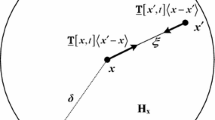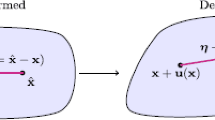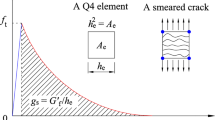Abstract
Different damage models are proposed in the literature to predict the behavior of dynamic fracture of brittle materials using the peridynamic formulation. The prototype micro-brittle material proposed by Silling and Askari (Comput. Struct. 83:1526−1535, 2005), PMB, and its modified version proposed by Du et al. (J. Elast. 132:197−218, 2018), DTT, concern bond-breakage damage criteria applied to a bond-based constitutive model. These models consider only the direct interaction between material points and have, therefore, a fixed Poisson’s ratio. Lipton et al. (J. Elast. 133:129−153, 2018) propose a state-based peridynamic model, LSJ, which, in addition to the strain state field, also considers a dilatational term and is coupled with a damage criterion that considers failure not only between bonds but also collectively, among all the bonds connected to a given material point. This criterion has two unrelated damage functions, one associated with the strain state field and the other one with its dilatational part only. In this work, we modify the LSJ model to consider only bond-breakage damage, rather than interaction-breakage damage, and call it the LSJ-T model. We also implement a bond-breakage damage criterion in the two-dimensional ordinary, state-based peridynamic model presented by Le et al. (Int. J. Numer. Methods Eng. 98:547−561, 2014), which we call the LPS-T model. In both cases, when the strain state of a bond reaches a critical value, rather than breaking, it is continuously damaged until bond-breakage occurs. To study the capability of these models in simulating the formation and the propagation of cracks, we have simulated numerically the experiment of a thin glass plate with an initial semi-crack under mode I loading. All the models were able to grasp the main features of crack propagation, such as the crack propagation speed and the crack pattern. Both the DTT and the LSJ-T models have predicted symmetric crack paths and no minor branches, which indicate a stable crack propagation path. We have also considered the experiment of a notched cement-mortar plate with a hole under quasi-static mode I loading. This experiment was simulated numerically using the aforementioned damage models together with a dynamic relaxation method. We have obtained solutions of the associated numerical problems, which yield a convergent sequence of response forces in terms of displacements. In addition, crack patterns predicted by these solutions are in good agreement with crack patterns observed experimentally.





















Similar content being viewed by others
Notes
Abaqus SoftwareTM is a product of Dassault Systèmes Simulia Corp.®, Providence, RI, USA.
References
Silling SA, Askari E (2005) A meshfree method based on the peridynamic model of solid mechanics. Comput Struct 83(17–18):1526–1535
Du Q, Tao Y, Tian X (2018) A peridynamic model of fracture mechanics with bond-breaking. J Elast 132(2):197–218
Lipton R, Said E, Jha P (2018) Free damage propagation with memory. J Elast 133(2):129–153
Le QV, Chan WK, Schwartz J (2014) A two-dimensional ordinary, state-based peridynamic model for linearly elastic solids. Int J Numer Meth Eng 98(8):547–561
Silling SA (2000) Reformulation of elasticity theory for discontinuities and long-range forces. J Mech Phys Solids 48(1):175–209
Silling SA (2003) Dynamic fracture modeling with a meshfree peridynamic code. In Computational Fluid and Solid Mechanics. Elsevier, 641–644
Kalthoff JF, Winkler S (1988) Failure mode transition at high rates of shear loading. DGM Informationsgesellschaft mbH, Impact Loading and Dynamic Behavior of Materials 1:185–195
Ha YD, Bobaru F (2010) Studies of dynamic crack propagation and crack branching with peridynamics. Int J Fract 162(1):229–244
Ha YD, Bobaru F (2011) Characteristics of dynamic brittle fracture captured with peridynamics. Eng Fract Mech 78(6):1156–1168
Bobaru F, Zhang G (2015) Why do cracks branch? A peridynamic investigation of dynamic brittle fracture. Int J Fract 196(1–2):59–98
Silling SA, Epton M, Weckner O, Xu J, Askari E (2007) Peridynamic states and constitutive modeling. J Elast 88(2):151–184
Foster JT (2009) Dynamic crack initiation toughness: Experiments and peridynamic modeling. PhD thesis, Sandia National Laboratories
Warren TL, Silling SA, Askari A, Weckner O, Epton MA, Xu J (2009) A non-ordinary state-based peridynamic method to model solid material deformation and fracture. Int J Solids Struct 46(5):1186–1195
Silling SA, Askari A (2014) Peridynamic model for fatigue cracking. SAND2014-18590. Albuquerque: Sandia National Laboratories
Zhou XP, Wang YT (2016) Numerical simulation of crack propagation and coalescence in pre-cracked rock-like Brazilian disks using the non-ordinary state-based peridynamics. Int J Rock Mech Min Sci 89:235–249
Zhou X, Wang Y, Qian Q (2016) Numerical simulation of crack curving and branching in brittle materials under dynamic loads using the extended non-ordinary state-based peridynamics. Eur J Mech A Solids 60:277–299
Tupek MR, Rimoli JJ, Radovitzky R (2013) An approach for incorporating classical continuum damage models in state-based peridynamics. Comput Methods Appl Mech Eng 263(15):20–26
Imachi M, Tanaka S, Bui TQ, Oterkus S, Oterkus E (2019) A computational approach based on ordinary state-based peridynamics with new transition bond for dynamic fracture analysis. Eng Fract Mech 206:359–374
Karpenko O, Oterkus S, Oterkus E (2020) An in-depth investigation of critical stretch based failure criterion in ordinary state-based peridynamics. Int J Fract 226:97–119
Ambati M, Gerasimov T, De Lorenzis L (2014) A review on phase-field models of brittle fracture and a new fast hybrid formulation. Comput Mech 55:383–405
Underwood P (1983) Dynamic relaxation. In Comput Methods for Transient Anal. North-Holland Publ. Co., 245–265
Aguiar AR, Fosdick RL (2014) A constitutive for a linearly peridynamic model. Math Mech Solids 19(5):502–523
Said E (2018) Non-local methods in fracture dynamics. LSU Doctoral Dissertations. https://www.digitalcommons.lsu.edu/gradschool_dissertations/4648
Hu W, Ha Y, Bobaru F (2010) Numerical Integration in Peridynamics. Tech. rep., University of Nebraska-Lincoln, Department of Mechanical & Materials Engineering
Seleson P (2014) Improved one-point quadrature algorithms for two-dimensional peridynamic models based on analytical calculations. Comput Methods Appl Mech Eng 282:184–217
Parks ML, Plimpton SJ (2008) PDLAMMPS 0.1. Tech. rep., Sandia National Laboratories
Kilic B, Madenci E (2010) An adaptive dynamic relaxation method for quasi-static simulations using the peridynamic theory. Theoret Appl Fract Mech 53(3):194–204
Alwar RS, Rao NR, Rao MS (1975) An alternative procedure in dynamic relaxation. Comput Struct 5(5–6):271–274
Bowden FP, Brunton JH, Field JE, Heyes AD (1967) Controlled fracture of brittle solids and interruption of electrical current. Nature 216:38–42
Silling SA, Demmie PN, Warren T (2007) Peridynamic simulation of high-rate material failure. Sandia National Lab.(SNL-NM), Albuquerque, NM, Technical Report
Freund LB (1972) Brittle fracture: Its study and application. J Elast 2(4):341–349
Abraham FF (2001) The atomic dynamics of fracture. J Mech Phys Solids 49(9):2095–2111
Ravi-Chandar K, Knauss WG (1984) An experimental investigation into dynamic fracture: III. On steady-state crack propagation and crack branching. Int J Fract 26:141–154
Ramulu M, Kobayashi AS (1985) Mechanics of crack curving and branching - a dynamic fracture analysis. In Dynamic fracture. Springer, 61–75
Döll W (1975) Investigations of the crack branching energy. Int J Fract. Springer, 11:184–186
Le QV, Bobaru F (2018) Surface corrections for peridynamic models in elasticity and fracture. Comput Mech 61(4):499–518
Acknowledgements
We thank the reviewers for their insightful comments. Financial support of São Paulo Research Foundation (FAPESP), grants n\(^\circ\) 2019/00428-7 and n\(^\circ\) 2020/04750-8, and of National Council for Scientific and Technological Development (CNPq), grant n\(^\circ\) 420099/2018-2, is gratefully acknowledged. Computational resources provided by the Minnesota Supercomputing Institute (MSI) at the University of Minnesota are also gratefully acknowledged.
Author information
Authors and Affiliations
Corresponding author
Ethics declarations
Conflict of Interest
The authors declare that they have no conflict of interest.
Rights and permissions
About this article
Cite this article
Aguiar, A.R., Patriota, T.V.B. Brittle Fracture Modeling Using Ordinary State-Based Peridynamics with Continuous Bond-Breakage Damage. J Peridyn Nonlocal Model 5, 81–120 (2023). https://doi.org/10.1007/s42102-021-00057-y
Received:
Accepted:
Published:
Issue Date:
DOI: https://doi.org/10.1007/s42102-021-00057-y




